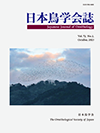Current issue
Displaying 1-11 of 11 articles from this issue
- |<
- <
- 1
- >
- >|
ARTICLES
-
Article type: ARTICLE
2023 Volume 72 Issue 2 Pages 181-194
Published: October 24, 2023
Released on J-STAGE: October 31, 2023
Download PDF (1523K) -
2023 Volume 72 Issue 2 Pages 195-210
Published: October 24, 2023
Released on J-STAGE: October 31, 2023
Download PDF (2070K) -
Article type: ARTICLE
2023 Volume 72 Issue 2 Pages 211-222
Published: October 24, 2023
Released on J-STAGE: October 31, 2023
Download PDF (2428K)
SHORT NOTES
-
Article type: SHORT NOTE
2023 Volume 72 Issue 2 Pages 223-233
Published: October 24, 2023
Released on J-STAGE: October 31, 2023
Download PDF (1143K) -
Japanese Marsh Warbler Locustella pryeri wintering in the Chugoku and Shikoku regions, western JapanArticle type: SHORT NOTE
2023 Volume 72 Issue 2 Pages 235-239
Published: October 24, 2023
Released on J-STAGE: October 31, 2023
Download PDF (830K) -
Article type: SHORT NOTE
2023 Volume 72 Issue 2 Pages 241-246
Published: October 24, 2023
Released on J-STAGE: October 31, 2023
Download PDF (783K)
OBSERVATIONAL DATA
-
Article type: OBSERVATIONAL DATA
2023 Volume 72 Issue 2 Pages 247-254
Published: October 24, 2023
Released on J-STAGE: October 31, 2023
Download PDF (1179K) -
Article type: OBSERVATIONAL DATA
2023 Volume 72 Issue 2 Pages 255-260
Published: October 24, 2023
Released on J-STAGE: October 31, 2023
Download PDF (966K) -
Article type: OBSERVATIONAL DATA
2023 Volume 72 Issue 2 Pages 261-263
Published: October 24, 2023
Released on J-STAGE: October 31, 2023
Download PDF (655K)
OTHER ARTICLES
-
2023 Volume 72 Issue 2 Pages 265-266
Published: October 24, 2023
Released on J-STAGE: October 31, 2023
Download PDF (570K) -
2023 Volume 72 Issue 2 Pages 267-269
Published: October 24, 2023
Released on J-STAGE: October 31, 2023
Download PDF (645K)
- |<
- <
- 1
- >
- >|
